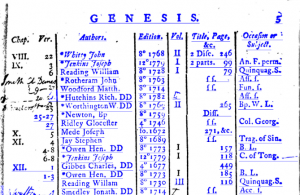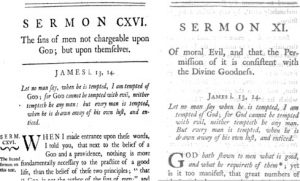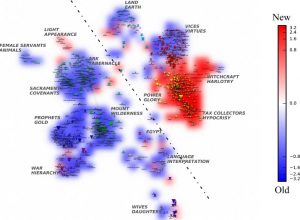


Citizen representations of regional democracy
5 November 2018
Labor Regulations Under Stress
19 November 2018In a study of sermons made by English preachers in the 17th and 18th centuries, medialab researcher Jean-Philippe Cointet and four sociologists and historians from American and German universities mapped biblical references used by priests from Anglican and dissident churches*. This work, presented in a Poetics journal article entitled “The (Protestant) Bible, the (printed) sermon, and the word(s): The semantic structure of the Conformist and Dissenting Bible, 1660–1780”, sheds lights on a whole swath of the history of faiths, and is notable for deploying new methods of textual analysis based on the quantitative and qualitative processing of empirical data. Awarded a prize from the American Sociological Association, this study is representative of a recent research trend in the humanities and social sciences: computational hermeneutics, which analyze and interpret cultural phenomena by drawing on quantitative methods and empirical data.
Mapping the words of the Bible
In their work, the researchers describe the semantic organization of the Old and New Testament at the verse level. This allows them to map the aspirations and fears expressed by both “camps”. To do so, they first created a semantic network of the Bible, that is, the way the figures, places, objects, and concepts are mentioned within the verses. Thanks to Automatic Language Processing (ALP) algorithms, they were able to detect the most relevant textual terms (like “female servants”, “righteousness”, “ox”, “harlotry”, “wrath”, “evildoers”, “witchcraft”, “glutton”, etc.).  Then, proceeding as would a reader who grasps the meaning of a paragraph by embracing the whole rather than focusing on a specific word, expressions that are frequently mentioned within or near a same phrase were linked within a lexical network. The network of terms thus created gave shape to thematic groupings that index single episodes – creation of the world or escape from Egypt – and enumerate recurring motifs in the narrative – vices and virtues, as well as elements of the material world, etc. This distant reading of the Bible is not a new exegesis of the sacred text, but rather a general map showing how the themes relate to one another and offering a reference point to compare different readings of the scared text.
Then, proceeding as would a reader who grasps the meaning of a paragraph by embracing the whole rather than focusing on a specific word, expressions that are frequently mentioned within or near a same phrase were linked within a lexical network. The network of terms thus created gave shape to thematic groupings that index single episodes – creation of the world or escape from Egypt – and enumerate recurring motifs in the narrative – vices and virtues, as well as elements of the material world, etc. This distant reading of the Bible is not a new exegesis of the sacred text, but rather a general map showing how the themes relate to one another and offering a reference point to compare different readings of the scared text.
Sermons and doctrines
This reference space serves as a canvas for grasping different ways the Bible can be read and perceived by different Churches.
To conduct this comparative study, the authors drew on a body of sermons: John Cooke’s “The Preacher’s Assistant”, which was compiled between 1660 and 1780, and which priests often used to prepare their sermons.  It indexed the most popular sermons by subjects addressed and verses quoted. Their author’s persuasion was also systematically specified. Conformists and dissidents were not equally interested in all passages of the Bible: non-conformists quoted Genesis much more often, while conformists preferred the asceticism of the gospel according to St. Matthew.
It indexed the most popular sermons by subjects addressed and verses quoted. Their author’s persuasion was also systematically specified. Conformists and dissidents were not equally interested in all passages of the Bible: non-conformists quoted Genesis much more often, while conformists preferred the asceticism of the gospel according to St. Matthew.
By using a digital version of this body of sermons, the authors of the study were able to associate the verses quoted by a given persuasion of preachers, allowing them to precisely identify the Bible chapters and parts particularly used by each Church. The subjects most frequently addressed in the preaching of dissidents reveal the extent to which the fear of death and last judgment are prevalent in this persuasion. In contrast, conformist sermons focused more on material and political issues, with majoritarian themes like rebellions, epidemics, and subsistence.
Prostitution or absolution
The authors also tracked the frequency of words and phrases quoted in the dissident and conformist sermons. This comparative analysis, closest to the text, allows for the Bible’s semantic map to be enhanced by an additional layer akin to a density map, shedding light on the thematic areas most often invoked in the sermons. The contrast between the maps of dissidents and of conformists reveals the divergence between the two persuasions.
The interpretation of these maps reveals the extent to which dissidents focused on morality issues. For example, their sermons most often use the vocabulary of prostitution and also testified to their fear of witchcraft. Meanwhile, conformist sermons focused on charity as a means to absolve sins.
By mapping the structure of the semantic network of Bible words, and the way conformist and non-conformist sermons deploy it, the study successfully captures the distinctiveness of each Church. Beyond this specific case, the study offers a general canvas for understanding different uses of the biblical text that could be reused in many contexts. Thus, in a more contemporary context, one might explore the quoting of verses by American politicians, or even the quoting of verses on Twitter. Other reference texts could also be used: legal articles more or less discussed by different parties represented at the Parliament, etc.
* “English Dissenters” or “nonconformists” are English Protestants who, beginning in the mid-16th century, gradually separated from the Church of the England.
Jean-Philippe Cointet, Associate Professor at the medialab, develops digital methods for the social sciences. He specializes in the analysis and visualization of bodies of text. His empirical work leads him to work in various fields: scientific communities, media, social networks, online commentary, political speeches, etc.





